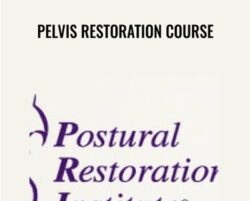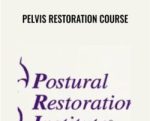COURSE INFORMATIONWe have taken video from the live 15-hour lecture and lab course including Power Point slides, demonstration, lab, and audience question and answer sessions. This home study course is available by online/digital which allows for viewing in the comfort of your home or office. You will have 21 days to complete the home study from the time you receive online access.This advanced lecture and lab course is designed to assist clinicians with those complex patients that are struggling to restore reciprocal function of their pelvis. The clinician will gain an appreciation for the influences of an asymmetrical pelvis and how this imbalance contributes to pelvis dysfunction. We will explore in detail the function of the pelvic inlet and outlet as it relates to anatomy, respiration, and asymmetry in a multiple polyarticular chain system. Participants will be able to restore pelvic and respiratory neutrality through a PRI treatment approach while keeping individual activities of daily living in mind.Education Level: AdvancedOBJECTIVESIdentify musculature of the pelvic inlet and outlet.Explain how the respiratory diaphragm integrates with pelvic diaphragm function and rehabilitation.Recognize pelvic asymmetry and understand the relationship of pelvic asymmetry and pelvis function required for rest, upright work, and pleasure related activity.Identify the recommended treatment algorithm for each PRI pattern pertaining to the pelvis.Outline how to design a postural isolation and inhibition program that includes the integration of appropriate pubo-sacral dynamics to restore normal reciprocal pelvic inlet and outlet function.AGENDAVideos 1-4Introduction to the Pelvic FloorLeft Anterior Interior Chain (AIC) and Posterior Exterior Chain (PEC) Influence on the PelvisExamination Tests & Assessment (Demonstration & Lab)Repositioning Through Integrated Isolation (Demonstration & Lab)Pelvic Floor Functional RelationshipsVideos 5-8Respiratory Influences on the Pelvic FloorRespiratory Examination & Assessment (Demonstration & Lab)Treatment Considerations of Pelvic Floor DysfunctionLeft AICPECPathologic PECPelvis Restoration Manual Techniques (Demonstration & Lab)REFERENCESAnatomy & PhysiologyAvery AF, O’Sullivan PB, McCallum M J. Evidence of pelvic floor muscle dysfunction in subjects with chronic sacro-iliac joint pain syndrome. Scientific Conference of the IFOMT, Perth, pp.35-38, 2000.Bendová P, Růzicka P, Peterová V, et al. MRI-based registration of pelvic alignment affected by altered pelvic floor muscle characteristics. Clin Biomech 2007;22:980–7.Bo K, Sherburn M, Allen T. Transabdominal ultrasound measurement of pelvic floor muscle activity when activated directly via a transversus abdominal muscle contraction. Arch Phys Med Rehabil: 2001:82.Broski SM, Murthy NS, et al. The adductor magnus “mini hamstring”: MRI appearance and potential pitfalls. Skeletal Radiol. 2016;45:213-219.DeLancey J. Structural support of the urethra as it relates to stress incontinence: The hammock hypothesis. Am J Obstet Gynecol 1994; 170: 1713-23.Gruss LT, Schmitt D. The evolution of the human pelvis: changing adaptations to bipedalism, obstetrics and thermoregulation. Phil. Trans. R. Soc. B 2015; 370:20140063. http://dx.doi.org/10.1098/rstb.2014.0063Hulme J. Pelvic pain and low back pain. Phoenix Publishing. Missoula, 2002:Hulme J. Beyond kegels: Fabulous four exercises and more to prevent and treat incontinence. 2nd ed. Phoenix Publishing. Missoula, 2002.Hodges PW. Is there a role for transversus abdominis in lumbo-pelvic stability? Manual Therapy. 1999: 4(2): 74-86.Lee D. The pelvic girdle: An approach to the examination and treatment of the lumbo-pelvic-hip region. Churchhill Livingston, 1999.Netter FH. Atlas of human anatomy. New Jersey, CIBA-GEIGY Corporation, 1992.Neumann P. Pelvic floor and abdominal muscle interaction: EMG activity and IAP. Int Urogynecol J. 2002: 13: 125-132.Nygaard I, Thompson F, et al. Urinary incontinence in elite nulliparous athletes. Obstetrics and Gynecology: 1994: 84: 2Nygard I. Does prolonged high impact activity contribute to later urinary incontinence? A retrospective cohort study of female olympians. Obstetrics and Gynecology: 1997:90:5.Obey MT, Broski SM, et al. Anatomy of the adductor magnus origin: Implications for proximal hamstring injuries. The Orthopaedic Journal of Sports Medicine. 2016;4(1). Accessed online January 2016 ahead of publishing.Pool-Gou dzwaard A, Dijke G, et al. Contribution of pelvic floor muscle to stiffness of the pelvic ring. Clinical Biomechanics 19 (2004) 564-571.Sapsford R. The pelvic floor – A clinical model for function and rehabilitation. Physiotherapy December 2001; 87: 620-629.Sapsford R, Hodges P, Richardson C. Co-activation of the abdominal and pelvic floor muscles during voluntary exercises. Neurourol Urodyn 2001: 20: 31-42.Shafik A. The histomorphologic structure of the levator ani muscle and its functional significance. Int. Urogynecol J 2002: 13: 116-124.Sultan A. Pudendal nerve damage during labour: prospective study before and after childbirth. British Journal of Obstetrics and Gynaecology. January 1994, Vol 101:22-28.Wallace K, Herman H. Female pelvic floor function, dysfunction and treatment level 1. Prometheus Group, Minneapolis 2008.Wijma J, et al. Perineal ultrasonography in women with stress urinary incontinence and controls: The role of the pelvic floor muscles. Gynecolocig and Obstetric Investigation, 32, 176-179.Willett GM, Keim SA, et al. An anatomic investigation of the ober test. Am J Sports Med. Published online January 11, 2016.RespirationAbe T, Kusuhara N, et al. Differential respiratory activity of four abdominal muscles in humans. J Appl. Physiol. 80(4): 1379-1389, 1996.Bordoni B, Marelli F, et al. The five diaphragms in patients following cardiac surgery in sternotomy: An observational study. Int J Complement Alt Med. 2017; 7(6):00245.Bordoni B, Zanier E. Anatomic connections of the diaphragm: influence of respiration on the body system. Journal of Multidisciplinary HealthCare. 2013:6 281–291.Bradley H, Esformes J. Breathing pattern disorders and functional movement. The International Journal of Sports Physical Therapy, Feb 2014, 28-38.Chaitow L. Breathing pattern disorders, motor control and low back pain. J Osteopathic Medicine, 2004; 7(1): 34-41.Clifton Smith T, Rowley J. Breathing pattern disorders and physiotherapy: inspiration for our profession. Physical Therapy Reviews. 2011;16(1):75-86.Gordon KE, Reed O. The role of the pelvic floor in respiration: A multidisciplinary approach. J Voice. 2018 Nov; Epub ahead of print.Hodges PW. Looking beyond the pelvic floor: An integrated clinical approach to the assessment and exercise management of continence and low back or pelvic pain. Combined Sections Meeting Las Vegas, NV February, 2009.Hodges PW, Sapsford R, Pengel LHM. Postural and respiratory functions of the pelvic floor muscles. Neurourol. Urodynma. 26:362-371, 2007.Johnson K. An integrated approach for treating the OB patient: Treating the five diaphragms of the body, part 1. AAO Journal. Winter 1991.Lee DG, et al. Stability, continence and breathing: The role of fascia following pregnancy and delivery. Journal of Bodywork & Movement Therapies. 2008 Oct;12(4):333-48.Park H, Han D. The effect of the correlation between the contraction of the pelvic floor muscles and diaphragmatic motion during breathing. J Phys Ther Sci. 2015 Jul; 27(7): 2113–2115.Peper E, Cohen T. Inhale to breathe away pelvic floor pain and enjoy intercourse. Biofeedback. 2017; 45(1):21-24.Perri M, Halford E. Pain and faulty breathing: A pilot study. J Bodywork and Movement Therapies 8: (4): 297-306, 2004.Santos R, Bulbena A, et al. Association between joint hypermobility syndrome and panic disorder. Am J Psychiatry 1998: 155: 1578-1583.Talasz H, Kofler M, et al. Breathing with the pelvic floor? Correlation of pelvic floor muscle function with expiratory flows in healthy young nulliparous women. Int Urogynecol J. 2010; 21:475-481.Talasz H, Kremser C, et al. Phase-locked parallel movement of diaphragm and pelvic floor during breathing and coughing – a dynamic MRI investigation in healthy females. Int Urogynecol J. 2011; 22:61-68.Zone of Apposition References – Postural Respiration PRI Course Manual. Available online www.posturalrestoration.com.Get Pelvis Restoration Course – Anonymous, Only Price $77 Treatment Considerations & Interdisciplinary IntegrationBasu S, Kakade PP, et al. Influence of abdominal and hamstring muscle activation exercises over iliotibial band stretching on a positive Ober’s test in subjects with low back pain. Global Journal for Research Analysis. May 2017 Volume 6 Issue-5Bo K. Pelvic floor muscle training is effective in treatment of female stress urinary incontinence, but how does it work? International Urogynecological Association: 2004: 15 76-84.Bordoni B, Zanier E. The continuity of the body: Hypothesis of treatment of the five diaphragms. The Journal of Alternative and Complementary Medicine. 2015; 21(4):237-242.Boyle K. Clinical application of the right sidelying respiratory left adductor pull back exercise. IJSPT 2013;8(3):349-358.Deindl FM, Vodusek DB, et al. Pelvic floor activity patterns: Comparison of nulliparous continent and parous urinary stress incontinent women: A kinesiological EMG study. British Journal of Urology (1994) 73, 413-417.Fernandes J, Chougule A. Effects of hemibridge with ball and balloon exercise on forced expiratory volume and pain in patients with chronic low back pain: an experimental study. International Journal of Medical Research & Health Sciences, 2017, 6(8): 47-52.Hodges PW, Heijnen I, et al. Postural activity of the diaphragm is reduced in humans when respiratory demand increases. J Physiology (2001), 537.3, 999-1008.Isbit J. Nature knows best. 2008.Jackson LR, Purvis J, Brown T. The effects of postural and anatomical alignment on speed, power and athletic performance in male collegiate athletes: a randomized controlled trial. IJSPT. August 2019;14(4):623-636.Kage V, Naidu S. Effect of iliotibial band stretching versus hamstrings and abdominal muscle activation on a positive Ober’s test in subjects with lumbopelvic pain: a randomized clinical trial. International Journal of Therapies and Rehabilitation Research. IJTRR 2015, 4: 4King PM, Myers CA, et al. Musculoskeletal factors in chronic pelvic pain. J Psychosom Obstet Gyneacol. 12 (1991), Suppl., 87-98.Nygard I, Glowacki C, Sallzma C. Relationship between foot flexibility and urinary incontinence in varsity athletes. Obstet Gynecol. 1996 Jun;87(6):1049-51.Oleksy L, Mika A, et al. The influence of pelvis reposition exercises on pelvic floor muscles asymmetry. Medicine (2019);98:2.O’Sullivan PB, Beales DJ. Changes in pelvic floor and diaphragm kinematics and respiratory patterns in subjects with sacroiliac joint pain following a motor learning intervention: A case series. Manual Therapy 12 (2007) 209-218.Pool-Goudzwaard AL, et al. Relations between pregnancy-related low back pain, pelvic floor activity and pelvic floor dysfunction. Int Urogynecol J Pelvic Floor Dysfunct. 2005 Nov-Dec;16(6):468-74. Epub 2005 Apr 1.Santa Mina D, Au D, et al. A pilot randomized trial of conventional versus advanced pelvic floor exercises to treat urinary incontinence after radical prostatectomy: A study protocol. BMC Urology. (2015)15:94.Sapsford RR, Hodges PW, Richardson CA, et al. Co-activation of the abdominal and pelvic floor muscles during voluntary exercises. Neurouro Urodyn 2001: 20: 31-42.Smith M, Coppieters MW, Hodges PW. Postural response of the pelvic floor and abdominal muscles in women with and without incontinence. Neurology and Urodynamics 26:377-385 (2007).Smith M, Hodges P. Incontinence and breathing disorders are associated with development of back pain. 10th World Congress on Pain; Sidney, Australia, 2005.Tenney HR, Boyle KL, DeBord A. Influence of hamstring and abdominal muscle activation on a positive ober’s test in people with lumbopelvic pain. Physiotherapy Canada. 2013;65(1)4-11.Thompson J, O’Sullivan P, et al. Difference in muscle activation patterns during pelvic floor muscle contraction and valsalva maneuver. Neurology and Urodynamics 25: 148-155 (2006).Muscular Skeletal Asymmetry and Influence on the Pelvic FloorBoyle K. Managing a female patient with left low back pain and sacroiliac joint pain with therapeutic exercise: a case report. Physiotherapy Canada. 2009;63(2):154-163.Lee LJ, Chang AT, Coppieters MW, Hodges PW. Changes in sitting posture induce multiplanar changes in chest wall shape and motion with breathing. Respiratory Physiology & Neurobiology 170 (2010) 236-245.Nguyen JK, Lind LR, et al. Lumbosacral spine and pelvic inlet changes associated with pelvic organ prolapse. Obstet Gynecol. 2000 Mar;95(3):332-6.Sahinkanat T, Arıkan DC, et al. Effects of lumbar lordosis and pelvic inlet orientation on the outcome of the transobturator tape sling operation in women. Arch Gynecol Obstet. 2011. Smith M, Russell A, Hodges P. Do incontinence, breathing difficulties, and gastrointestinal symptoms increase the risk for future back pain? The Journal of Pain. Aug 2009;10(8):876-886.Muscular Influence on Pelvic Floor FunctionDeindl FM, Vodusek DB, et al. Pelvic floor activity patterns: Comparison of nulliparous continent and parous urinary stress incontinent women. A kinesiological EMG study. British Journal of Urology (1994); 73:413-417.Depledge J, et al. Management of symphysis pubis dysfunction during pregnancy using exercise and pelvic support belts. Physical Therapy. 2005;85(12):1290-1300.Hodges P, Smith M, et al. Breathing with the pelvic floor: Coordinated activity of the pelvic floor muscles during inspiratory and expiratory efforts. The University of Queensland. Available at https://www.ics.org/Abstracts/Publish/46/000390.pdfHodges PW, Heijnen I, GAndevia S. Postural activity of the diaphragm is reduced in humans when respiratory demand increases. J Physiology (2001), 537.3, 999-1008.Junginger B, Baessler K, Sapsford R. Effect of abdominal and pelvic floor tasks on muscle activity, abdominal pressure and bladder neck. Int Urogynecol J (2010) 21:69-77.Radziminska A et al. The impact of pelvic floor muscle training on the quality of life of women with urinary incontinence: a systematic literature review. Clinical Interventions in Aging. 2018; 13:957-965.Pelvic Floor Mid ZoneO’Sullivan PB, Beales DJ. Changes in pelvic floor and diaphragm kinematics and respiratory patterns in subjects with sacroiliac joint pain following a motor learning intervention: A case series. Manual Therapy 12 (2007) 209-218.Thompson J, O’Sullivan P, et al. Difference in muscle activation patterns during pelvic floor muscle contraction and valsalva maneuver. Neurology and Urodynamics 25: 148-155 (2006).Urquhart DM., Hodges PW, Allen TJ, Story IH. Abdominal Muscle Recruitment A Range of Voluntary Exercises. Manual Therapy 10 (2005) 144-153.PRE-READINGANATOMYMuscular Structures of the Pelvic FloorPelvic Inlet: diaphragm, rectus femoris, sartorius, internal obliques, transverse abdominis, iliacusPelvic Outlet: hamstrings, IC adductor magus, gluteus maximus, piriformis, coccygeus, pubococcygeus, obturator, iliococcygeus, puborectalis, urogenital diaphragmAnterior Interior Chain (AIC)Muscles: Diaphragm, Psoas, Iliacus, TFL, Vastus Lateralis, Biceps FemorisThere are two anterior interior polyarticular muscular chains in the body that have a significant influence on respiration, rotation of the trunk, ribcage, spine and lower extremities. They are composed of muscles that attach to the costal cartilage and bone of rib 7 through twelve to the lateral patella, head of the fibula and lateral condyle of the tibia. These two tracts of muscles, one on the left side of the interior thoraco-abdominal-pelvic cavity and one on the right, are composed of the diaphragm and the psoas muscle. With the iliacus, tensor fasciae latae, biceps femoris and vastus lateralis muscles this chain provides the support and anchor for abdominal counter force, trunk rotation and flexion movement.Opposition Muscles: Hamstrings, Gluteals, Internal ObliquesPosterior Exterior Chain (PEC)Muscles: Latissimus Dorsum, Quadratus Lumborum, Posterior Intercostals, Serratus Posterior, Iliocostalis LumborumOpposition Muscles: Abdominal ObliquesPELVIC FLOOR RESTORATION TESTSSTANDING REACH TESTPositionPatient stands upright with knees fully extended and arms at side of trunk.Ask patient to align feet with each other so they are parallel.Make sure clothing is unrestricted.Keep shoes on.Mechanics Without Hip ShiftAsk patient to reach down toward floor as arms move forward and hips move back.Instruct patient to keep back rounded in attempting to touch toes with fingertips.Encourage the patient to exhale as they reach toward the toes.Measure distance from fingers to floor in inches.Mechanics With Hip ShiftAsk patient to reach down toward floor as right fingers overlap left fingers, arms move forward and as hips move back.Instruct patient to keep back rounded in attempting to touch left toes with both left and right fingertips, while shifting left hip back.Encourage the patient to exhale when reaching toward the toes with knees fully extended.Measure distance directly in front of left toes from fingers to the floor in inches.Repeat procedure on other side by asking patient to reach down toward floor and right toes, accordingly.Left AIC: Inability reflects:Lack of right anterior left posterior inlet, lack of left anterior and right posterior outlet, hyperactivity of left anterior and right posterior inlet, or hyperactivity of right anterior and left posterior outletPEC: Inability reflects: Lack of bilateral posterior inlet and bilateral anterior outlet, or hyperactivity of bilateral anterior inlet and bilateral posterior outlet.*ability to touch toes with + Adduction Drop Test & + PADT = Pathological PECPELVIC ASCENSION DROP TEST (PADT)The patient lies on their side with the top and lower hips and knees flexed to 90 degrees.The patient is then instructed to actively bring the top leg back to neutral while maintaining 90 degrees of knee flexion, and to touch their knee to the mat. This represents a negative test.A positive test is indicated by the inability of the active leg’s pelvic floor to ascend secondary to the left outlet’s inability to abduct.PASSIVE ABDUCTION RAISE TEST (PADT)The patient lies on his or her side with their bottom knee and hip flexed at 70-90°. Their top knee and hip will remain straight (0-degrees). Passively stabilize the patient’s innominate with one hand as the other hand passively moves their leg into abduction. Standing behind the patient usually provides more examiner biomechanical comfort in lifting the leg. Patients with tight right intercostal walls and short and strong right adductors will demonstrate limited passive abduction when compared to the other side. Usually the examiner will feel lateral buttressing of the femoral head on the lateral superior acetabulum as the femur is abducted. When right thoracic abduction or sidebending occurs, discontinue the test.A positive test is indicated by a restriction on one or both sides that does not allow sufficient abduction secondary to lack of outlet adduction. Usually seen on the right side especially if Left Adduction Drop Test is positive in a Left AIC oriented patient or a patient has a right Hruska Adduction Lift Test of less than a 3.Get Pelvis Restoration Course – Anonymous, Only Price $77 FUNCTIONAL SQUAT TESTLEVEL 1: Ability to initiate a squat by slightly bending knees while trunk remains in flexion. Inability reflects lack of posterior pelvic rotation and hyperactive back extensors.LEVEL 2: Ability to begin squatting, moving bottom back and knees forward while trunk remains in flexion. Inability reflects lack of femoral adduction, hyperactive hip flexors, and overactive FA ER’s.LEVEL 3: Ability to squat bringing bottom below knee level while keeping heels down and trunk flexed. Inability reflects tight intercostals and hyperactive anterior / posterior tibialis.LEVEL 4: Ability to squat keeping heels down, trunk flexed and bottom to heels. Inability reflects hyperactive quads and gastroc-soleus.LEVEL 5: Ability to maximally squat keeping heels down and trunk flexed while keeping center of gravity through heels. Inability reflects lack of maximal AF IR and synchronized mechanics of diaphragm and pelvic floor respiration.Adduction Drop TestSee Myokinematic Restoration Review GuideHruska Adduction Lift TestSee Myokinematic Restoration Review GuideHruska Abduction Lift TestSee Myokinematic Restoration Review GuideRECOMMENDED READINGThese references are attached below as PDF files. After clicking on them, you may have to “Allow Add On” if it pops up an error message at the top of the internet browser. You also may need to download a free version of PDF software, allowing you to view the articles below. Please contact us if you continue to have difficulty accessing the articles below.Boyle K, Olinick J, Lewis C. The value of blowing up a balloon. North American Journal of Sports Physical Therapy. Sept 2010;5(3):179-188.Sahinkanat T, Arıkan DC, et al. Effects of lumbar lordosis and pelvic inlet orientation on the outcome of the transobturator tape sling operation in women. Arch Gynecol Obstet. 2011.Nguyen JK, Lind LR, et al. Lumbosacral spine and pelvic inlet changes associated with pelvic organ prolapse. Obstetrics and Gynecology. 2000.COURSE REGISTRATIONRegister online or by phoneFormat: Online/DigitalYou will receive an email within 24 hours after purchasing the home study with instructions to login and begin your home study online. (*Please note that you must order before 3pm CST on Friday to receive your online access information before the weekend. If you order the home study after 3pm on Friday, you will receive your online access information on Monday). You will receive all materials online including the videos and course manual (which you will be able to download and print). You will also complete the post-test and course evaluation form online. You will need high speed internet in order to watch the videos (the videos are NOT downloadable). Once you have been emailed your online access information, you will have 21 days to complete the course online before your access to the course materials will expire.You will receive a Certificate of Completion by email if post-examination test is passed (miss 8 or fewer) and course evaluation summary is completed.COURSE MATERIALSOnline/Digital Format – Each registrant will receive online access to the approximately 15 hours of course video content, as well as access to download and print the entire course manual (printing the manual is recommended). The post-test and course evaluation form will also be completed online. You will have 21 days to complete the course material, before your online access expires.Special Needs RequestsIf you have a disability and require accommodation in order to fully participate in this course, please contact us at least two weeks prior to the course date or prior to purchasing any online home study course so that arrangements can be made.Cancellation and Refund PolicyTo cancel your registration, please call as soon as possible for a full refund. Cancellations and refunds will not be accepted once the course registrant has set up their online username/password. Get Pelvis Restoration Course – Anonymous, Only Price $77 Tag: Pelvis Restoration Course – Anonymous Review. Pelvis Restoration Course – Anonymous download. Pelvis Restoration Course – Anonymous discount.
Pelvis Restoration Course – Anonymous
₹12,118.00








